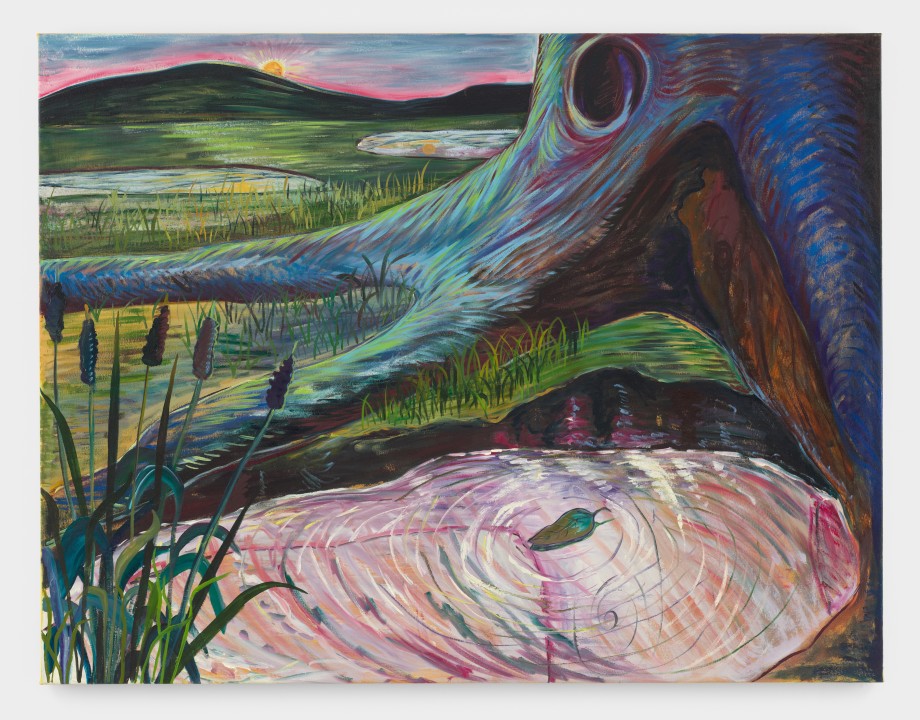Sim Smith is delighted to present All the Land is Spoken For, the second solo show with the gallery by British artist Kemi Onabulé. The exhibition explores our relationship to our environment, as consumers of a seemingly unending resource. Across the paintings in the exhibition, Onabulé traverses superficially magical forests through a veil of neon brushstrokes, transporting us with her and compelling us to look through her technicoloured lens at the result of our actions on our world.
All the Land is Spoken For refers to a land, our land, our need to own the place that we come from, a need to put our name on it in personal, cultural or ecological terms. This need is not so much for the land itself or for nature or sustainability but about an urge to consume. The title relates to the moment we start to understand that most of the land is spoken for and we are needing to go further into the wilderness.
Onabulé is known to portray the everyman in her paintings, drawing on universal, collective experience. In this exhibition, the image of the figure has been replaced in many of the paintings by the figure of the tree. It is a structure that has limbs, a tall body and stands erect in the landscape, it changes with the weather and the seasons;
“…there is so much to enjoy from a tree as a painter, you can paint its skeleton as if it were a body.”
-Kemi Onabulé, January 2024
Onabulé is an artist who is preoccupied by nature in a way that is exhilarating to her, the paintings act as an embrace of her personal understanding of the land. The depiction of trees, forests, moorlands and meadows is very natural to Onabulé. Drawing on her rich Greek, English and Nigerian heritage, this body of work is particularly grounded in the history of English landscape painting. This was less of a conscious decision and more a case of observing her surroundings rather than projecting onto something unknown.
“I know puddles, rain, deciduous trees…I have really enjoyed working with my immediate experience for this show. It feels natural to do so, this needs to be here. This belongs in the work and the way I paint.”
-Kemi Onabulé, January 2024
The figure in this exhibition has taken a back seat and instead, in many works the viewer is the figure, sitting amongst the trees or looking down towards the sea. Onabulé has cropped vistas, unconsciously creating frames through which to experience the landscape. In Receding Flood we are at ground level, sitting at the roots of a tree like a child, we feel the pull of the English fairy tale but also it feels claustrophobic, there is a darker dynamic at play across this exhibition. The largest painting Onabulé has made to date is in this show, Forgetting the Storm, it is a piece that grew naturally in scale with the sprawling subject matter of the natural world. Here, however, a figure is present, it is a self-portrait of Onabulé herself lying in a puddle in the forest. This painting is the amalgamation of all of her sentiments about our environment. She lies on top of the land but can never be fully absorbed into it, there is a distance in her, a sadness, a need that cannot be met.
The colour palette in this exhibition changes through the seasons through which the paintings were made. There are high pigments in summer paintings and darker, danker works which turn to autumn and ultimately winter. There is a sense of toxicity that has intensified in this body of work, depicted through the use of neon across Fever Dream-like landscapes. These are not bucolic or peaceful places, they are troubled with dark hues and choppy brushstrokes. Suns and moons are a constant in every work; fierce and burning or soft, full and heavy, they take on many forms across many moods and seasons.
Onabulé’s highly imaginative landscapes disrupt our view of outwardly beautiful scenes and our relationship with our environment within the paintings. Through the individual and personal visions of the natural world, she transports us through the broad tradition of historical European painting to a verdant English countryside where not all is as it seems. The essential harmony and purity of nature here has been grappled with, coerced through a lens of one who sees our ruinous relationship with nature for what it is.

